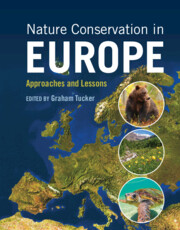Book contents
- Nature Conservation in Europe
- Nature Conservation in Europe
- Copyright page
- Dedication
- Contents
- Contributors
- Preface
- Acknowledgements
- Glossary, Abbreviations and Country Codes
- Chapter 1 Introduction: Aims, Scope, Structure and Key Information Sources
- Chapter 2 Europe’s Nature and Conservation Needs
- Chapter 3 The International Drivers of Nature Conservation, Their Objectives and Impacts on Nature Conservation Policies and Actions in Europe
- Chapter 4 Nature Conservation Policy, Legislation and Funding in the EU
- Chapter 5 Conclusions, Lessons Learnt and Implications for the Future
- Chapter 6 Austria
- Chapter 7 Belgium
- Chapter 8 Republic of Bulgaria
- Chapter 9 Republic of Croatia
- Chapter 10 Cyprus
- Chapter 11 The Czech Republic
- Chapter 12 Denmark
- Chapter 13 Estonia
- Chapter 14 Finland
- Chapter 15 France
- Chapter 16 Germany
- Chapter 17 Greece
- Chapter 18 Hungary
- Chapter 19 Ireland
- Chapter 20 Italy
- Chapter 21 Latvia
- Chapter 22 Lithuania
- Chapter 23 The Netherlands
- Chapter 24 Poland
- Chapter 25 Portugal
- Chapter 26 Romania
- Chapter 27 Slovakia
- Chapter 28 Slovenia
- Chapter 29 Spain
- Chapter 30 Sweden
- Chapter 31 United Kingdom
- Appendix Habitats Directive Annex I Habitat Types Referred to in This Book
- Index
- References
Chapter 5 - Conclusions, Lessons Learnt and Implications for the Future
Published online by Cambridge University Press: 11 May 2023
- Nature Conservation in Europe
- Nature Conservation in Europe
- Copyright page
- Dedication
- Contents
- Contributors
- Preface
- Acknowledgements
- Glossary, Abbreviations and Country Codes
- Chapter 1 Introduction: Aims, Scope, Structure and Key Information Sources
- Chapter 2 Europe’s Nature and Conservation Needs
- Chapter 3 The International Drivers of Nature Conservation, Their Objectives and Impacts on Nature Conservation Policies and Actions in Europe
- Chapter 4 Nature Conservation Policy, Legislation and Funding in the EU
- Chapter 5 Conclusions, Lessons Learnt and Implications for the Future
- Chapter 6 Austria
- Chapter 7 Belgium
- Chapter 8 Republic of Bulgaria
- Chapter 9 Republic of Croatia
- Chapter 10 Cyprus
- Chapter 11 The Czech Republic
- Chapter 12 Denmark
- Chapter 13 Estonia
- Chapter 14 Finland
- Chapter 15 France
- Chapter 16 Germany
- Chapter 17 Greece
- Chapter 18 Hungary
- Chapter 19 Ireland
- Chapter 20 Italy
- Chapter 21 Latvia
- Chapter 22 Lithuania
- Chapter 23 The Netherlands
- Chapter 24 Poland
- Chapter 25 Portugal
- Chapter 26 Romania
- Chapter 27 Slovakia
- Chapter 28 Slovenia
- Chapter 29 Spain
- Chapter 30 Sweden
- Chapter 31 United Kingdom
- Appendix Habitats Directive Annex I Habitat Types Referred to in This Book
- Index
- References
Summary
The chapter briefly describes the evolution of EU environmental policy, before primarily focusing on the Birds Directive and Habitats Directive (i.e. the Nature Directives), in particular their objectives and key measures for habitats and species. These comprise two key pillars of measures: 1) general species protection; 2) the creation of the Natura 2000 network of protected areas as well as their protection from developments (through appropriate assessments) and the establishment of their necessary conservation measures. The main sources of funding for the Nature Directives and broader nature conservation are identified. Other supporting EU environmental policies and legislation are outlined, including in relation to environmental impact assessments, strategic environmental assessments, the Environmental Liability Directive, the Water Framework Directive, the Marine Strategy Framework Directive and other maritime policy instruments, air pollution, the Invasive Alien Species Regulation, and the Common Agricultural Policy. A summary is provided of the EU Biodiversity Strategies of 1998, and for 2010, 2020 (with a list of the targets and related actions) and 2030.
Keywords
- Type
- Chapter
- Information
- Nature Conservation in EuropeApproaches and Lessons, pp. 106 - 141Publisher: Cambridge University PressPrint publication year: 2023



